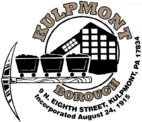This information was received on August 18, 2003, from a local resident.
This article was printed in The News Item on Friday, June 27, 1975.
I thought you would like to know how our beloved hometown Kulpmont got its start.
Kulpmont has always been a true melting pot. Since the beginning of the town itself, people of many nationalities have called Kulpmont “home”. It comes as a surprise to many when they learn that the first people to live in Kulpmont were blacks. Old records reveal that when the Scott Colliery shaft was sunk in 1898. African Americans were used to do this work. They lived with their families in “company homes” which were located at the extreme end of what is now Poplar Street near the collier. Several of these homes have been remodeled and are still standing…
When their work at the mines was finished, the blacks left the community and their homes were occupied by people of various nationalities who came to work in the mines.
First to settle in the community were the English and Dutch who worked as mine bosses and builders. In fact, in the early days of Kulpmont, it could be said that the Dutch literally built the town, since the majority of early builders and contractors in Kulpmont were Dutch. Names such as Evert, Landis, Hall, Mummaw, Wolfgang, Moyer, Miller, Payne, Hornberger, Dunkleberger, Turlis and Apichella are associated with the early contractors in Kulpmont.
The Dutch and English comprised the majority of the early builders. In 1905, Kulpmont experienced a ‘building boom” when many immigrant families arrived to work in the mines and to settle in the community. Most of the early settlers were of Polish and Italian descent, a fact that is reflected in the names of people still found in the town today…
Kulpmont was also the early home of many Hungarian families who came to the town from Diamondtown, Natalie and surrounding areas.
One of the highlights of the year for these Hungarian families was the “Suzleti” or Fall Festival Dance which attracted young and old alike.
Family names such as Kovach, Katona, Delbo, Conni, Molnar, Szido, Petrovich, Nemeth, Ponto, Horvath, and Szoke were always represented at the dance.
If an observer wants to determine what nationalities were most prevalent in Kulpmont during its early days, one only has to study the clubs which were established. The Polish Club, Italian Club, Russian Club and Hungarian Club all give evidence to the fact that these people made up a sizeable portion of Kulpmont’s early settlers.
However, many other nationalities comprised. Kulpmont’s early melting pot. The Irish played an important part in contributing to Kulpmont’s league of nations. Records indicate that all of the town’s first public school teachers were Irish. Miss Dooley, Miss Driscall, Miss McCarthy, and Miss Obrien are remembered as the first school teachers in Kulpmont during the early part of the 1900’s.
Jewish families also contributed to the early history of Kulpmont. In fact, the town’s first doctor was Jewish, Dr. Pearl. The Silverman family is another Jewish family with early roots in Kulpmont.
Even Arabians were represented during its early days. Several Arabian families, complete with Arabian horses, once lived on Chestnut Street.
All of these nationalities are now blended into one harmonious melting pot to form a community which has long been noted for its hospitality and friendliness. In fact, Kulpmont is regarded by many as having the friendliest climate in Pennsylvania.
However, the town wasn’t always like this. At one time it was noted not for its friendliness, but for its hostility.
Older residents often speak of the days when every nationality lived together in a certain part of town and formed a tight curtain against those of other backgrounds. Ethnic and religious prejudice was once so strong that many “horror stories” from these years still survive.
Hostility was once especially strong between the Polish and Italians. Older residents recall that at one time, many Italians lived on the East side of town and the Polish on the West side. If a member of either ethnic group would walk into the other’s “territory”, a fight would often follow. Of course, each ethic group remembers these days differently, but most agree that “peaceful harmony” would never be words used to describe early Kulpmont.
Kulpmont was once the scene of many firebombings and so much violence that it earned a “tough”, reputation with other towns. In fact the violence was once so bad that state police headquarters was located in Kulpmont to try to curb it. Around 1908, state police headquarters was located in the Turner residence at Pine and Eighth Streets. After several months, the troopers were returned in Shamokin.
Still, for many years, the violence continued. Firebombings were once so common in Kulpmont that area insurance agents were given ordres not to issue any fire insurance to residents of certain sections of Kulpmont.
However, the town’s reputation for discord soon turned to a reputation for harmony and friendship. Through inter-marriages and cultural assimilation, Kulpmont has become an amalgamated melting pot of which every resident can be proud. Because each nationality contributed its best, the town now rates as ONE OF THE FINEST IN THE REGION.
